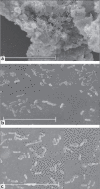Effect of cumin (Cuminum cyminum) seed essential oil on biofilm formation and plasmid Integrity of Klebsiella pneumoniae
- PMID: 20548937
- PMCID: PMC2881652
- DOI: 10.4103/0973-1296.59967
Effect of cumin (Cuminum cyminum) seed essential oil on biofilm formation and plasmid Integrity of Klebsiella pneumoniae
Abstract
Seeds of the cumin plant (Cuminum cyminum L.) have been used since many years in Iranian traditional medicine. We assessed the effect of cumin seed essential oil on the biofilm-forming ability of Klebsiella pneumoniae strains and on the integrity of a native resistance plasmid DNA from K. pneumoniae isolates, treated with essential oil. Antibacterial coaction between the essential oil and selected antibiotic disks were determined for inhibiting K. pneumoniae. The essential oil of the cumin seeds was obtained by hydrodistillation in a Clavenger system. A simple method for the formation of biofilms on semiglass lamellas was established. The biofilms formed were observed by scanning electron microscopy (SEM). The effect of essential oil on plasmid integrity was studied through the induction of R-plasmid DNA degradation. The plasmid was incubated with essential oil, and agarose gel electrophoresis was performed. Disk diffusion assay was employed to determine the coaction. The essential oil decreased biofilm formation and enhanced the activity of the ciprofloxacin disk. The incubation of the R-plasmid DNA with essential oil could not induce plasmid DNA degradation. The results of this study suggest the potential use of cumin seed essential oil against K. pneumoniae in vitro, may contribute to the in vivo efficacy of this essential oil.
Keywords: Biofilm; Cuminum cyminum; Klebsiella pneumoniae; essential oil; plasmid.
Conflict of interest statement
Figures



Similar articles
-
Effect of subinhibitory concentrations of cumin (Cuminum cyminum L.) seed essential oil and alcoholic extract on the morphology, capsule expression and urease activity of Klebsiella pneumoniae.Int J Antimicrob Agents. 2008 Nov;32(5):432-6. doi: 10.1016/j.ijantimicag.2008.05.009. Epub 2008 Aug 19. Int J Antimicrob Agents. 2008. PMID: 18715764
-
Ultrasonic Nanoemulsification of Cuminum cyminum Essential Oil and Its Applications in Medicine.Int J Nanomedicine. 2020 Feb 5;15:795-807. doi: 10.2147/IJN.S230893. eCollection 2020. Int J Nanomedicine. 2020. PMID: 32103937 Free PMC article.
-
In vitro and in vivo antifungal activity of Cuminum cyminum essential oil against Aspergillus aculeatus causing bunch rot of postharvest grapes.PLoS One. 2020 Nov 24;15(11):e0242862. doi: 10.1371/journal.pone.0242862. eCollection 2020. PLoS One. 2020. PMID: 33232384 Free PMC article.
-
Chemistry, technology, and nutraceutical functions of cumin (Cuminum cyminum L): an overview.Crit Rev Food Sci Nutr. 2013;53(1):1-10. doi: 10.1080/10408398.2010.500223. Crit Rev Food Sci Nutr. 2013. PMID: 23035918 Review.
-
Cumin (Cuminum cyminum L.) from traditional uses to potential biomedical applications.Chem Biodivers. 2015 May;12(5):733-42. doi: 10.1002/cbdv.201400305. Chem Biodivers. 2015. PMID: 26010662 Review.
Cited by
-
Beyond the Risk of Biofilms: An Up-and-Coming Battleground of Bacterial Life and Potential Antibiofilm Agents.Life (Basel). 2023 Feb 11;13(2):503. doi: 10.3390/life13020503. Life (Basel). 2023. PMID: 36836860 Free PMC article. Review.
-
Development of quorum-based anti-virulence therapeutics targeting Gram-negative bacterial pathogens.Int J Mol Sci. 2013 Aug 9;14(8):16570-99. doi: 10.3390/ijms140816570. Int J Mol Sci. 2013. PMID: 23939429 Free PMC article. Review.
-
Natural Medicine a Promising Candidate in Combating Microbial Biofilm.Antibiotics (Basel). 2023 Feb 2;12(2):299. doi: 10.3390/antibiotics12020299. Antibiotics (Basel). 2023. PMID: 36830210 Free PMC article. Review.
-
Antimicrobial Activity of Spices Popularly Used in Mexico against Urinary Tract Infections.Antibiotics (Basel). 2023 Feb 3;12(2):325. doi: 10.3390/antibiotics12020325. Antibiotics (Basel). 2023. PMID: 36830236 Free PMC article. Review.
-
Wound healing effect of Carum carvi L. on the incised skin wound in male rats: Histopathology, total protein and biomechanical evaluations.Vet Med Sci. 2022 Nov;8(6):2726-2737. doi: 10.1002/vms3.961. Epub 2022 Oct 14. Vet Med Sci. 2022. PMID: 36239922 Free PMC article.
References
-
- Iacobellis NS, Cantore PL, Capasso F, Senatore F. Antibacterial activity of Cuminum cyminum L. and Carum carvi L. essential oils. J Agric Food Chem. 2005;53:57–61. - PubMed
LinkOut - more resources
Full Text Sources
Molecular Biology Databases
